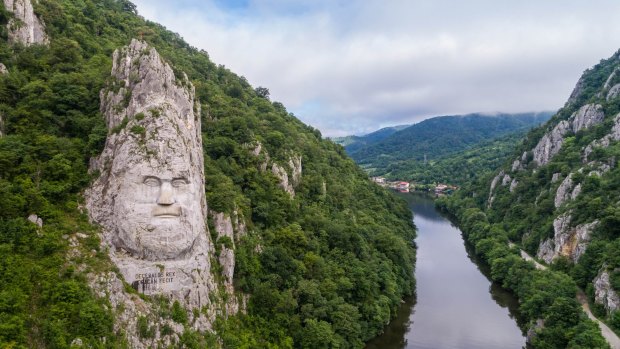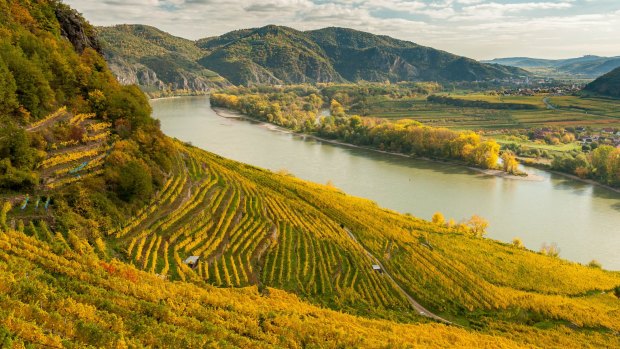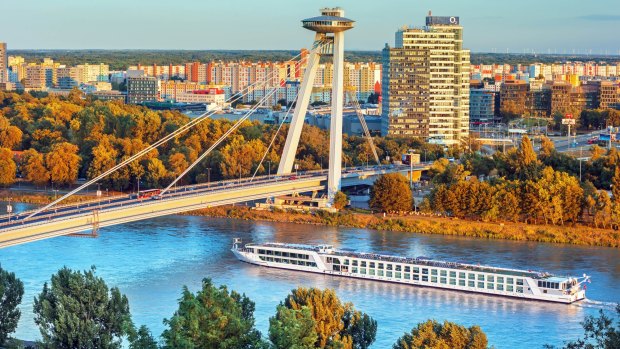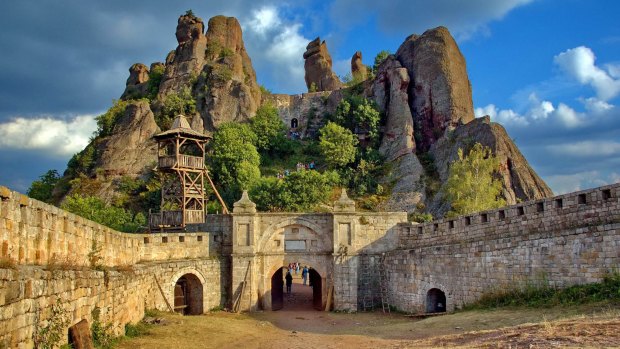This was published 5 years ago
Danube River, Europe cruising guide and things to do: 20 highlights

The 130 kilometres of narrow limestone gorges that channel the Danube through the Carpathian Mountains along the Serbian-Romanian border provide the Danube's most dramatic scenery.Credit: Shutterstock
1. EXPLORE RIVERINE HISTORY
Europe's second-longest river flows 2860 kilometres through 10 countries in central and eastern Europe, and has been vital to defence, trade and artistic inspiration since it marked the Roman Empire's borders. It's a mostly cheerful waterway, wending through rolling, castle-topped landscapes, vineyards and later rugged mountains, before emptying into the Black Sea. Along its banks lie great cities, prominent trading towns, cathedrals and palaces for a culture-crammed journey.
2. TRACE THE DANUBE'S SOURCE
The mighty Danube has modest beginnings in pretty Donaueschingen in Germany's Black Forest, where the Breg and Brigach streams meet. An ornamental fountain in the grounds of the town's castle marks the spot: peer in and you can see fresh springwater creating bubbles below. Downstream at Donauwörth, which has a pleasant old town, the Danube becomes navigable by trading vessels. See donaueschingen.de and donauwoerth.de
3. GO MEDIEVAL IN REGENSBURG
This magnificent German town's 1140 stone bridge across the Danube made it rich on north-south trade. Its medieval merchants built fortified houses and a saint-studded cathedral. The old town retains a wonderful lived-in feeling thanks to its many shops and large student population. Regenburg's medieval outline is best admired from across the river, where landscape painters capture its ever-changing river reflections on canvas. See tourismus.regensburg.de
4. TURN BAROQUE IN PASSAU
Though not far from Regensburg, former prince-bishopric Passau is a delightful contrast thanks to extensive baroque-era remodelling from Italian-inspired architects. It sits on the Austrian border, and already hints at a more Austrian-minded frivolity. The pastel-shaded town perches on an outcrop above the confluence of the dark Danube and milky-blue Inn, with winding cobblestone streets leading upwards to a gold-draped cathedral. See tourism.passau.de
5. GET ARTY IN LINZ
Straddling 12 small hills fronting the Danube River, this lively provincial Austrian city has the expected pretty old town but also an unexpected array of ultra-contemporary buildings and a reputation for cutting-edge arts. The glowing blue Ars Electronica Centre on the riverfront explores the interface between arts and technology, the pink Lentos Art Museum tackles modern art, and the Kulturquartier combines restaurants with arthouse cinemas and multi-media studios. See linztourismus.at
6. BOGGLE AT MELK ABBEY
One of Europe's most outrageous baroque monasteries sits in bright yellow on a bluff above the Danube before it slides into the gorges of Austria's Wachau region. It isn't just outsized but lavishly decorated with cherubs, saints, red marble, plasterwork more ornate than wedding-cake icing and enough gold to sink a ship. The monastery's church and library are a particular marvel of overblown baroque madness. See stiftmelk.at
7. WINE TASTE IN THE WACHAU VALLEY

Created by a gentle sweep of Danube through northern Austria, this charming fairytale valley features fortified old towns, age-blackened farmhouses and peach orchards, but it's the vineyards that should be your focus. Cellar doors such as wine cooperatives Domäne Wachau and Winzer Krems provide the chance to taste and learn about interesting – and excellent – Austrian varietals such as Grüner Veltliner and Blauer Zweigelt. See lower-austria.info
8. FALL IN LOVE WITH DÜRNSTEIN
This Austrian village might be the most romantic spot on the Danube thanks to its location between river and cliffs, cute old town, erupting boxes of flowers and fine blue baroque bell tower above a cupid-encrusted church. Richard the Lionheart was imprisoned in the now-ruined castle above and rescued by a wandering minstrel. If you really want to turn up the romance levels, check into Renaissance-era castle Hotel Schloss Dürnstein. See duernstein.at
9. PEDAL THE CYCLE PATHS
If you're keen to get active, hit the Donauradweg (Danube Cycle Path), which runs 365 kilometres from Passau in Germany to Bratislava in Slovakia. It often hugs the riverbanks and is particularly scenic between Linz and Vienna. Good sign posting and a dense network of small hotels make individual travel easy, or you can join organised cycling tours and have your accommodation and luggage transfers pre-arranged. See donauregion.at
10. TUNE INTO VIENNA
The Danube's premier city turns its back on the river, which isn't (by a long way) the Austrian capital's chief attraction. For locals, its riverbanks are mostly a recreation zone, with June's Danube Island Festival the biggest free open-air music event in Europe, attracting three million revellers. At other times of year, you'll have to settle for a tourist-concert rendition of The Blue Danube waltz. See wien.info
11. CHILL OUT IN BRATISLAVA

The modest Slovakian capital has no big museums, art galleries, palaces or must-see sights but, granted time off from sightseeing duties, you'll find it a relaxing, charming and surprisingly buzzing city. The agreeable, mostly pedestrianised old town has been lovingly renovated and is crammed with eateries and bars where you can sample the produce of Slovakia's many microbreweries. See visitbratislava.com
12. GO AROUND THE BEND IN HUNGARY
Where the river slides into Hungary and bulges into the Danube Bend you'll find some of Hungary's oldest towns. Szentendre is jammed with churches, museums and artists' studios, while ancient Esztergom is Hungary's former capital and religious centre, pleasantly sited on the river and boasting an enormous cathedral and gold-laden treasury. Cloud Castle above pretty village Visegrád offers sweeping Danube views. See hellohungary.com
13. LOOK UP – AND DOWN – IN BUDAPEST
The Hungarian capital has spent the last 20 years sprucing up its city centre, which languished during Communist times. It's a magnificent showcase of 20th century (and particularly art nouveau) architecture, with a few earlier-era bridges, neo-Gothic battlements and spa baths. You'll get a crick in your neck from all the beauty. You can also admire the ensemble from above, atop several well-placed hills. See budapestinfo.hu
14. DISCOVER THE 'UNKNOWN' DANUBE
At the point where the Danube (almost) defines the Croatian-Serbian border you'll find Croatian region Slavonia, notable for vineyards, stud farms, bird-filled wetlands and a hearty cuisine of stews and smoked meats. River cruises often stop at Vukovar to make excursions to attractive university city Osijek, which sits on Danube tributary the Drava and has an old-town core of cobbled squares and baroque buildings. See croatia.hr
15. BEAT THE COMING CROWDS IN NOVI SAD
Get to this unsung Serbian city before it becomes European Capital of Culture in 2021 and enters the tourist consciousness. It straddles the Danube, old town on one side and mighty fortress on the other, and is filled with elegant architecture, café terraces and parks. Nearby Sremski Karlovci, also on the Danube, is one of Serbia's loveliest small towns. See novisad.travel
16. PARTY ON IN BELGRADE
The Serbian Capital sits above the confluence of the Sava and Danube rivers, crowned by an Ottoman-era citadel. Bullet-marked buildings are a war reminder, but the city centre has made a comeback, with restored neoclassical buildings, a vast new Orthodox cathedral and renewed energy in its restaurants. It's one of Europe's current creative, party-loving hotspots, with a hopping nightlife and innumerable live-music venues. See tob.rs
17. FLOAT THROUGH THE IRON GATES
The 130 kilometres of narrow limestone gorges that channel the Danube through the Carpathian Mountains along the Serbian-Romanian border provide the Danube's most dramatic scenery. At times the cliffs rear 300 metres and cruise ships have barely enough space to pass each other. Orthodox chapels and crumbling fortresses cling to the misty riversides, providing additional atmosphere. See serbia.travel and romaniatourism.com
18. BE IMPRESSED BY BULGARIA

Though towns on the Danube in Bulgaria aren't anything special, river cruisers here are in for a magnificent surprise, since this is one of few river-cruise destinations in Europe that provides views to snow-capped mountains. Shore excursions take you away from the river to the scenic ruins of Belogradchik fortress, 16th-century Ottoman town Arbanasi, and former Bulgarian capital Veliko Tarnovo, crowned by a fortress. See bulgariatravel.org
19. SEE SILISTRA
This picturesque final stop on the Bulgarian Danube is surrounded by hills with lovely views across the river to Romania. Apricot and cherry orchards are splendid in springtime. The ancient town is scattered with Roman and Ottoman remains and has a good archaeological museum. Nearby Srebarna Nature Reserve is a significant stopover on avian migration routes, and is World Heritage listed. See bulgariatravel.org
20. DO THE DELTA
The Danube ends with an impressive natural bang. Europe's most unspoiled (and second-largest) river delta is comprised of three main Danube estuaries, plus lakes and waterways, floating reed beds and sand dunes. It's beaten only by the Barrier Reef and Galapagos for biodiversity, most notably 300 bird species including eagles, cormorants, ibis, pelicans and Arctic geese. See romaniatourism.com
Sign up for the Traveller Deals newsletter
Get exclusive travel deals delivered straight to your inbox. Sign up now.